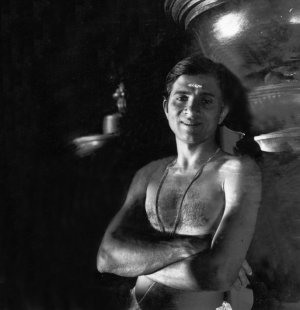
|
 |

|
 |
Margi Madhu: Nepathya is my dream project - Lalitha Venkat November 26, 2008  Son of celebrated guru Moozhikkulam Kochukuttan Chakyar, Margi Madhu's first love is Koodiyattam, a mix of dance, music, mime and theatre. Apart from acting he has written the acting manual for four plays, 'Dooth Ghadodgajam,' 'Kanchukeeyam,' 'Karnabharam,' and 'Macbeth.' Along with his elder brother Margi Narayanan he has been striving to bring back audiences to an art that would have long become extinct: This he does as a lecturer of Koodiyattam at the Sree Sankaracharya University of Sanskrit where he is inspiring a new generation of performers and at 'Nepathya,' a centre he started in Moozhikulam in 2003. He has performed in many national and international venues, including the prestigious Kennedy Center at Washington DC, USA in June 1977. Margi Madhu has also performed for the International jury of UNESCO. You are the son of celebrated guru Moozhikkulam Kochukuttan Chakyar. How has that influenced you to become an exponent of Koodiyattam? To continue in a performing art which does not have a popular image and which needs a long painful training, one should have a deep performing culture in his mind. There is no way other than seeing the art form again and again and being a part of it. That was my initial fuel which I acquired, watching my father and uncle (Late Padma Bhushan Ammannoor Madhava Chakyar) who became my gurus later with their creative heights and minimum remuneration with which they could hardly sustain themselves. How hard was your training and how has that helped you reach where you are now? It was too hard that at a point in my life where the colorful campus of the outside world and the ambitious professions which have more salaries persuaded me to leave the strain which I was undergoing both physically and mentally. It was Late D Appukuttan Nair, the founder of Margi, who made me stand strong in Koodiyattam with his intelligent comments and philosophical way of explaining the situations. And moreover I found love that nourished the artist in me. In childhood, my training started when I was 11. It started early in the morning at 4am. I had to stand in the basic posture, which needs painful control over the body and had to render different ragas as slokam to master the 24 ragas which we used. After school, in the evening also there were lessons. That would be mainly body centered movements and eye movements. When I completed matriculation, my father and uncle had been posted as gurus in Margi Trivandrum. So I also went with them. There, except the morning and evening classes, there was full stretch training in Gurukula style along with which Sanskrit studies also went side by side. In what way has the UNESCO recognition of Koodiyattam as an intangible heritage, helped the art form? It attracted the media and people who were ignorant about Koodiyattam to it. So it gave the art form more spaces to perform than earlier. At the same time the Govt. which was not so interested in this type of silent but brilliant art form, happened to consider it and give more encouragement than earlier. A network of different Koodiyattam schools was to be formed to undertake various projects for the revival of the art. How far has that been implemented? There were some weak attempts but not successful. Those who were interested, they cannot touch the pulses of the artists. An artist oriented understanding of their circumstances and needs only can make a true revival. Still it is a dream. What are the challenges facing Koodiyattam now? What do you think should be done to revive the art form? The challenges can be included in the boundary of time and space. The global changes which demands no depth but spreading, no strain but gain and that considers time equal to money, poses so many challenges to the art form. But the historical depth of Koodiyattam enabled it to overcome these kinds of challenges at different times of history. At the same time, the artistes who are living with it have not undergone the luxury and greedy life on any of the historical points. I believe that simplicity, if they keep to it, will help revival. But the contemporary artistes should overcome the challenges with the awareness of it, which the ancestors did unknowingly. What are your favorite roles? Ravana, Arjuna, Sugreeva, Vidushaka. Do you have any suggestions for widening the repertoire of Koodiyattam? The repertoire of Koodiyattam is so vast, as it takes five to forty-one days to complete one act of a play. If it is necessary to compose a new act, we should do it in the same depth which the present performance is having. Otherwise it will end as an experiment rather than a contribution to the repertoire. Can you tell us about Nepathya, your institute for Koodiyattom, at Moozhikulam? Nepathya is my dream project. Where the students can achieve excellence in the art form and the exchanges between the artistes take place in its truthfulness and where the hard work and dedication give rise to a new generation for the art form. Also it is an experiment to work in a democratic atmosphere of art oriented co-operation without any hierarchical mannerisms where everyone is free to voice their opinion. As a part of this idea, we built a Koothambalam outside the temple premises only for performances. Your comment on the Chennai season. This is my second demonstration in Krishna Gana Sabha. It is quite delightful to know that there is a gathering for art sake. Contact: e-mail: margimadhu@yahoo.co.in |